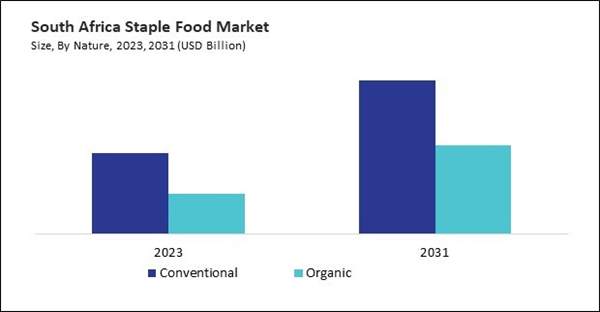The Latin America, Middle East and Africa Staple Food Market is projected to witness market growth of 8.4% CAGR during the forecast period (2024-2031).
The Brazil market dominated the LAMEA Staple Food Market by Country in 2023, and is forecast to continue being a dominant market till 2031; thereby, achieving a market value of $55.94 billion by 2031. The Argentina market is showcasing a CAGR of 9.6% during (2024 - 2031). Additionally, The UAE market would register a CAGR of 7.6% during (2024 - 2031).
The market continually evolves, driven by shifting consumer preferences, technological advancements, trade dynamics, and sustainability imperatives. These trends shape the production, distribution, and consumption of essential agricultural commodities. The rise of plant-based diets is influencing essential food consumption patterns. More consumers are reducing their intake of animal products and incorporating plant-based alternatives into their diets.
In addition, sustainability considerations are profoundly impacting the market. Consumers, producers, and policymakers increasingly prioritize sustainable agricultural practices that minimize environmental impact. These practices include organic farming, agroecology, conservation agriculture, and integrated pest management. Sustainable sourcing and production methods are becoming important consumer criteria when selecting essential foods.
High rates of hunger and food insecurity drive a constant and urgent demand for essential foods such as maize, wheat, and other grains. These foods form the basis of diets for many South Africans, particularly those in lower-income brackets who rely heavily on affordable and filling staple foods. According to the Government of South Africa, out of almost 17,9 million households in SA in 2021, 15 percent (2,6 million) and 6 percent (1,1 million) stated that they have inadequate and severe inadequate access to food, respectively. Additionally, Brazil is a significant global producer and exporter of essential crops, including soybeans, corn, sugarcane, coffee, and oranges. The country’s expanding agriculture sector has significantly increased production volumes, contributing to global food supply chains. Brazil’s agricultural exports are crucial in meeting international demand for staple foods, influencing global market prices and trade dynamics. According to the Government of Brazil, Brazil’s 2022/23 crop is expected to break a new record in national grain production. Total numbers will add up to over 312.4 million tons of soy, corn, cotton, rice, and other products. Volume exceeds the recent record - for the previous harvest, which was 270.9 million tons - by 41.5 million tons. Hence, the region's expansion of the agriculture sector and high food insecurity drive the market's growth.
The Brazil market dominated the LAMEA Staple Food Market by Country in 2023, and is forecast to continue being a dominant market till 2031; thereby, achieving a market value of $55.94 billion by 2031. The Argentina market is showcasing a CAGR of 9.6% during (2024 - 2031). Additionally, The UAE market would register a CAGR of 7.6% during (2024 - 2031).
The market continually evolves, driven by shifting consumer preferences, technological advancements, trade dynamics, and sustainability imperatives. These trends shape the production, distribution, and consumption of essential agricultural commodities. The rise of plant-based diets is influencing essential food consumption patterns. More consumers are reducing their intake of animal products and incorporating plant-based alternatives into their diets.
In addition, sustainability considerations are profoundly impacting the market. Consumers, producers, and policymakers increasingly prioritize sustainable agricultural practices that minimize environmental impact. These practices include organic farming, agroecology, conservation agriculture, and integrated pest management. Sustainable sourcing and production methods are becoming important consumer criteria when selecting essential foods.
High rates of hunger and food insecurity drive a constant and urgent demand for essential foods such as maize, wheat, and other grains. These foods form the basis of diets for many South Africans, particularly those in lower-income brackets who rely heavily on affordable and filling staple foods. According to the Government of South Africa, out of almost 17,9 million households in SA in 2021, 15 percent (2,6 million) and 6 percent (1,1 million) stated that they have inadequate and severe inadequate access to food, respectively. Additionally, Brazil is a significant global producer and exporter of essential crops, including soybeans, corn, sugarcane, coffee, and oranges. The country’s expanding agriculture sector has significantly increased production volumes, contributing to global food supply chains. Brazil’s agricultural exports are crucial in meeting international demand for staple foods, influencing global market prices and trade dynamics. According to the Government of Brazil, Brazil’s 2022/23 crop is expected to break a new record in national grain production. Total numbers will add up to over 312.4 million tons of soy, corn, cotton, rice, and other products. Volume exceeds the recent record - for the previous harvest, which was 270.9 million tons - by 41.5 million tons. Hence, the region's expansion of the agriculture sector and high food insecurity drive the market's growth.
List of Key Companies Profiled
- Cargill, Incorporated
- Danone S.A.
- JBS S.A.
- Archer Daniels Midland Company
- The Kraft Heinz Company
- Kellogg Company
- General Mills, Inc.
- Unilever PLC
- Arla Foods amba
Market Report Segmentation
By Nature- Conventional
- Organic
- Cereals
- Vegetables
- Fruit
- Oil
- Sugar
- Roots & Tuber
- Others
- Wholesale Distributors
- Direct-to-Consumer (D2C)
- Retail Stores
- Online Retailers
- Others
- Brazil
- Argentina
- UAE
- Saudi Arabia
- South Africa
- Nigeria
- Rest of LAMEA
Table of Contents
Chapter 1. Market Scope & Methodology
Chapter 2. Market at a Glance
Chapter 3. Market Overview
Chapter 4. LAMEA Staple Food Market by Nature
Chapter 5. LAMEA Staple Food Market by Product Type
Chapter 6. LAMEA Staple Food Market by Distribution Channel
Chapter 7. LAMEA Staple Food Market by Country
Chapter 8. Company Profiles
Companies Mentioned
- Cargill, Incorporated
- Danone S.A.
- JBS S.A.
- Archer Daniels Midland Company
- The Kraft Heinz Company
- Kellogg Company
- General Mills, Inc.
- Unilever PLC
- Arla Foods amba
Methodology

LOADING...









